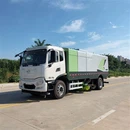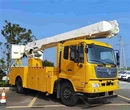Everyone knows that the suction truck is a new type of environmental sanitation vehicle that collects and transfers, cleans and transports sludge and sewage, and avoids secondary pollution. The suction truck can self suction and discharge, and has a fast working speed and large capacity. Relatively speaking, it is more suitable for collecting and transporting feces, mud, and liquid substances such as crude oil. The entire suction vehicle mainly relies on suction for suction operations, but sometimes there may be situations where the suction is low, which is quite troublesome for many users. So what are the reasons for these? Let's answer with everyone now. It uses a vacuum pump to exhaust the air inside the tank, forming a vacuum, thereby creating negative pressure and generating suction through the pressure of the air.
If the suction pipes or suction pipes of these vehicles leak, and there is a leak in the vacuum exhaust pipe, it will not be able to reach the vacuum state, and it will not be able to generate enough suction, resulting in insufficient suction. Additionally, the vacuum pumps of these vehicles are worn, and there are generally two types of wear on the vacuum pumps: wear on the shell and wear on the scraper blades, A vacuum pump that has been in use for a long time will experience slow wear. If the casing is severely worn, the entire inner wall of the casing is not smooth, and grooves appear, maintenance will not be effective at this time, and only replacement can be carried out. The wear of the scraper is also common. After the pipe segment is worn, it cannot adhere to the inner wall of the suction pump to form a vacuum. Therefore, it is necessary to replace the scraper in a timely manner.
Another issue is that the gates of these suction trucks are either closed or insufficiently opened, and there is a high possibility that the suction pipes are blocked. At this time, even if the vacuum pump generates sufficient suction, the suction inside the gates or pipes will be blocked, making it difficult for this sewage to smoothly enter these suction tanks, creating a false impression of low suction. Another aspect is that the exhaust pipe is not unobstructed, because the gas that is usually expelled from the tank flows from the anti overflow valve exhaust pipe to the water vapor separator, and then enters the vacuum pump along the pipeline from the water vapor separator. The gas that needs to be expelled is forcibly squeezed out of the vacuum pump, and then discharged outside the vehicle after passing through these separators. If these areas are blocked, it can also cause poor exhaust and result in insufficient suction.









